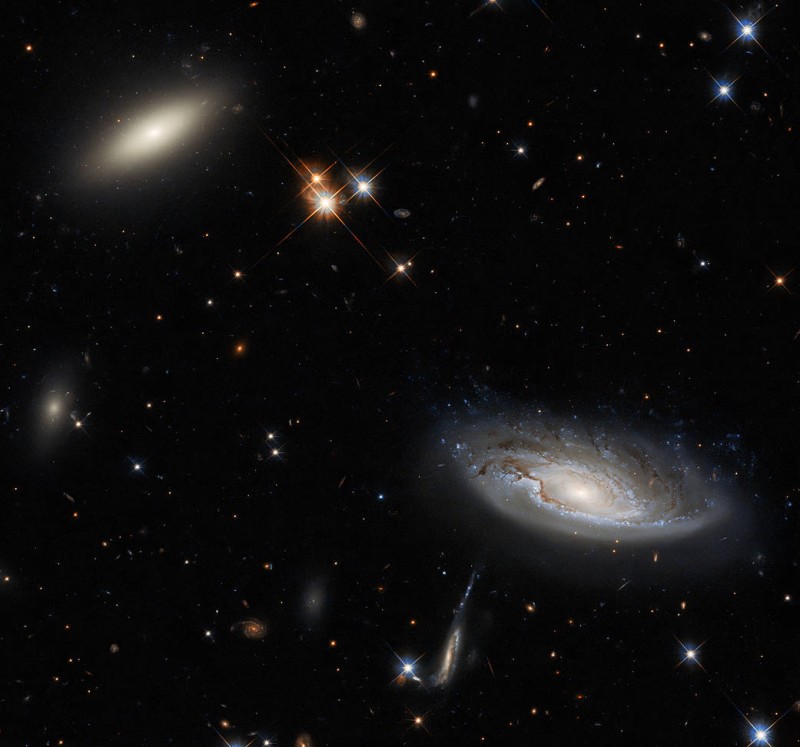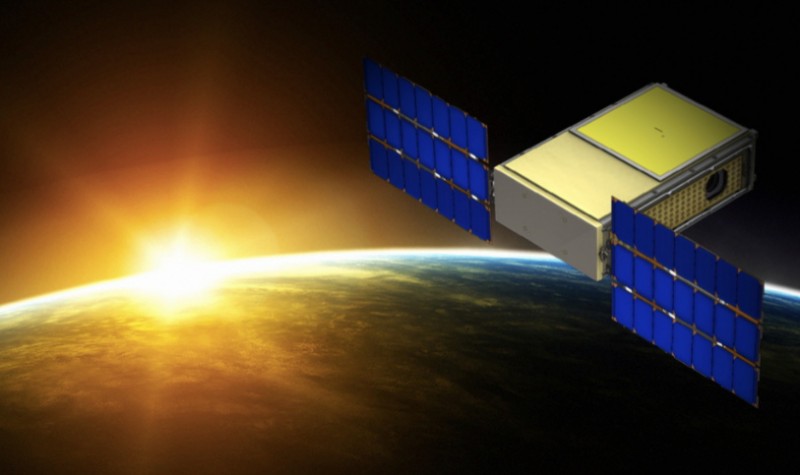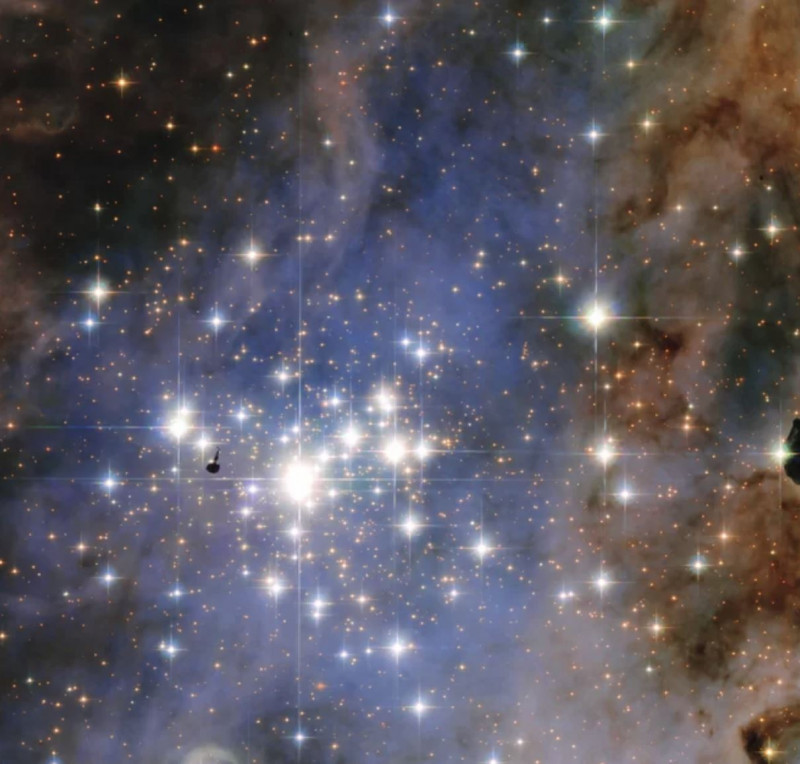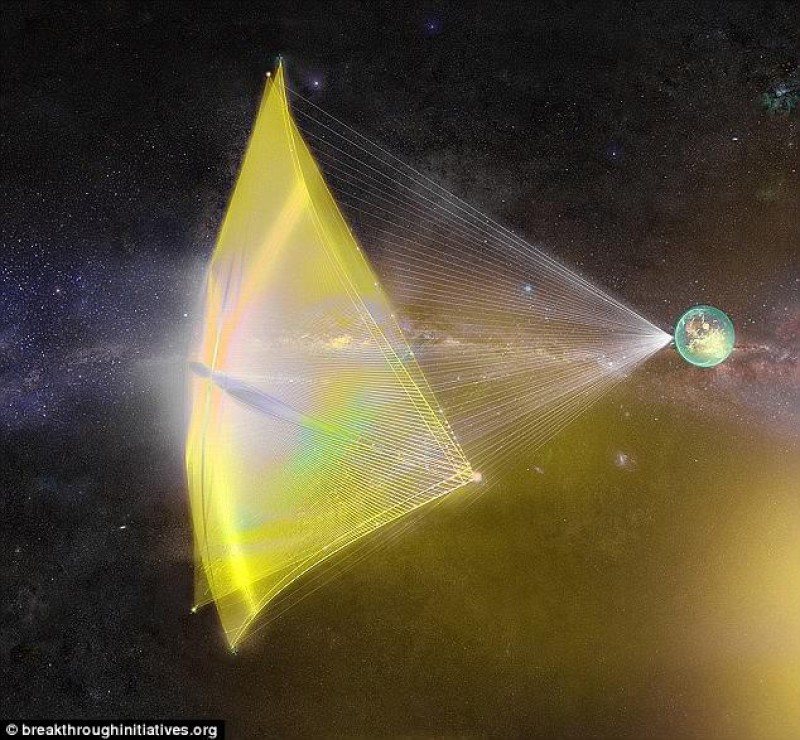Articles
Image of the Day
Friday, July 9th 2021 04:49 PM
Hubble Glimpses a Galactic Duo
Two enormous galaxies capture your attention in this spectacular image taken with the NASA/ESA Hubble Space Telescope using the Wide Field Camera 3 (WFC3). The galaxy on the left is a lenticular galaxy, named 2MASX J03193743+4137580. The side-on spiral galaxy on the right is more simply named UGC 2665. Both galaxies lie approximately 350 million light-years from Earth, and they both form part of the huge Perseus galaxy cluster.
Perseus is an important figure in Greek mythology, renowned for slaying Medusa the Gorgon – who is herself famous for the unhappy reason that she was cursed to have living snakes for hair. Given Perseus’s impressive credentials, it seems appropriate that the galaxy cluster is one of the biggest objects in the known universe, consisting of thousands of galaxies, only a few of which are visible in this image. The wonderful detail in the image is thanks to the WFC3’s powerful resolution and sensitivity to b...
Read More
Read More
In 2020, NASA Will Send Living Things to Deep Space for First Time Since Apollo
Tuesday, May 21st 2019 09:48 PM
NASA hasn't launched living creatures to deep space (on purpose) since 197
Artist's illustration of NASA's Biosentinel cubesat in space.
(Image: © NASA)
NASA is getting ready to launch living creatures to deep space for the first time in nearly five decades.
Agency engineers are putting together a briefcase-size spacecraft called BioSentinel, which will carry yeast cells into orbit around the sun to help scientists better understand the radiation environment beyond our planet's protective magnetic bubble.
BioSentinel is one of 13 cubesats flying aboard the Artemis 1 mission, which is currently targeted for mid-2020. That's 47.5 years after NASA last launched organisms beyond low-Earth orbit — the Apollo 17 astronauts, who reached the moon in December 1972. (Well, those are the last organisms launched on purpose, anyway; a few hardy microbes stow away on every robotic planetary mission.)
But A...
Read More
Read More
MUSE spots a jet bursting from an infant star
Thursday, February 7th 2019 08:26 PM
The Large Magellanic Cloud (LMC) is one of the most beautiful cosmic sights that a southern observer can take in with their naked eye. At just over 150,000 light-years from Earth, this large(ish) satellite galaxy of the Milky Way is roughly 14,000 light-years wide and bursting with newly formed stars. Recently, astronomers homed in on a particularly fertile region of the LMC named LHA 120-N 180B — informally known as N180 B. This nebula, which serves as a sort of stellar nursery, is chock full of ionized hydrogen, or H II. By studying such a glowing glob of gas, not only do astronomers gain insight into what's going on in the area, it also makes for a particularly stunning image, like the one seen above.
The newly discovered jet, known as HH 1177, is seen here bursting from its source — a young, massive star within a star-forming region of the Large Magellanic Cloud.
ESO, A McLeod et al.
But deep inside N180 B hides a smaller yet equally brea...
Read More
Read More
'Vibrating Universe' Shares Astronomy with Deaf Students
Thursday, February 7th 2019 08:24 PM
What does a star feel like? A team of scientists put astronomy on a vibrating sound stage in order to tackle such questions.
The result is a presentation about the "Vibrating Universe," which was developed in order to make astronomy more accessible for people who are deaf by converting scientific phenomena into vibrations.
"For our workshop we decided to focus on astronomy — a gateway to science — because of the breathtaking imagery it offers, the big questions it tackles, and its increasingly interdisciplinary nature," Mario De Leo-Winkler, a lead on the project and director of the National System of Researchers of Mexico, said in a statement. "We used storytelling, videos, and images in the workshop to bring meaning to the sounds of the universe."
De Leo-Winkler worked with astronomers at the University of California, Riverside, and teachers at the California School for the Deaf, Riverside — a public school for deaf students —...
Read More
Read More
Life on Earth may have been made possible by an ancient, violent collision
Friday, January 25th 2019 12:47 PM
Life on Earth
Did the violent, cosmic collision that created the moon make life on Earth possible? One new study suggests so.There are a number of theories for how life originated on Earth, many of which try to explain how our planet got the ingredients for life: elements like carbon and nitrogen.Previously, scientists have suggested that meteorites delivered life-giving elements to Earth. While the isotopic signatures of these elements on Earth match up with these objects, the ratio of carbon to nitrogen isn’t quite right. While the meteorites thought to have delivered elements crucial to life to Earth (known as carbonaceous chondrites) have 20 parts carbon for each part nitrogen, that ratio is about 40-1 on Earth.Instead, these crucial elements may have been delivered in a staggering collision, says a group of petrologists at Rice University. Scientists know that a long-ago collision between the proto-Earth and a Mars-sized object created the moon — that same impact...
Read More
Read More
Methane rain falls on Titan's north pole from cloudless skies
Tuesday, January 22nd 2019 02:55 PM
NASA’s Cassini orbiter captured the north pole on Saturn’s largest moon looking like a wet sidewalk after a bit of rain. This rainfall, which scientists take to signify a change in season on the moon, brought summer to Titan’s northern hemisphere earlier than scientists had predicted. This is the first time summer rainfall has ever been seen on the moon. But strangely, the rain came without any clouds.
Summer Rain on Titan
The Cassini spacecraft may be long gone, but the data it collected in its long journey continues to reveal incredible truths about Saturn and its moons. Now, researchers from the University of Idaho in Moscow have used Cassini’s observations to pinpoint rainfall on Titan’s north pole. Noticing what is described as “the wet-sidewalk effect,” the team spotted light reflecting off of Titan’s north pole in a way that indicates the presence of rainfall.But, the team has yet to find an explanation for the rainfa...
Read More
Read More
The Future of Ultrahigh-End Space Travel
Wednesday, December 12th 2018 10:59 PM
Virgin Galactic will launch the budding space-travel industry sometime within the next year, the company says, when it begins ferrying aspiring cosmonauts on 90-minute suborbital trips. Passengers will spend four minutes floating in zero gravity, check out the curvature of the Earth, and be home in time for dinner. So far, 600 customers have booked seats at $250,000 apiece.
But for those with loftier space-travel ambitions—and deeper pockets—there is a slew of new luxury start-ups that want to install you in regal floating hotels that will actually orbit the Earth. You’ll need a hearty checkbook. And maybe some baby wipes.
Axiom Space, a Houston-based firm, intends to offer a 10-day cruise around the Earth in its luxury space station that will include Wi-Fi, custom-designed leisure suits, and a padded, cream-colored interior dreamed up by French designer Philippe Starck. In advance of takeoff, 15 weeks of astronaut training will be provided.
The price of admissio...
Read More
Read More
Comet tails can be shaped by the Sun's magnetic field
Friday, November 9th 2018 01:43 AM
It turns out that the sun’s magnetic field can shape and push the dust of a comet’s tail, according to a revelation made possible by one young scientist’s innovative new image-processing technique.Comet DustIn 2007, scientists were elated when NASA’s STEREO spacecraft laid its “eyes” on Comet c/2006 P1, also known as Comet McNaught — named after astronomer Robert McNaught, who discovered the comet a year prior. Comet McNaught, which is part of a group called “the Great Comets,” was one of the brightest comets visible from Earth within the past 50 years. And scientists were lucky because, when STEREO, made up of twin satellites, was turned on, Comet McNaught passed right in front of it, creating a wealth of incredible data and images.Scientists found that the comet’s structured tail had distinct bands of dust stretching over 100 million miles behind it. But how exactly this tail was broken up and struct...
Read More
Read More
Mysterious interstellar asteroid 'Oumuamua could be a giant solar sail 'sent from another civilization to look for signs of life,' claim astronomers
Saturday, November 3rd 2018 12:55 AM
A mysterious asteroid called Oumuamua, the first interstellar object ever seen in the solar system, could be a gigantic alien solar sail send to look for signs of life, a new study has claimed.
Astronomers from the Harvard Smithsonian Center for Astrophysics (CfA) analyzed the strange cigar shape of the object, and an unexpected boost in speed and shift in trajectory as it passed through the inner solar system last year.
They concluded that the strange asteroid 'might be a lightsail of artificial origin.'
The study – 'Could Solar Radiation Pressure Explain 'Oumuamua's Peculiar Acceleration?', which recently appeared online – was conducted by Shmuel Bialy, a postdoctoral researcher at the CfA's Institute for Theory and Computation (ITC) and Professor Abraham Loeb, the director of the ITC, the Frank B. Baird Jr. Professor of Science at Harvard University, and the head chair of the Breakthrough Starshot Advisory Committee.
The researchers...
Read More
Read More
NASA Needs Help Shipping Cargo to Its Future Lunar Space Station
Wednesday, October 31st 2018 12:19 AM
NASA is asking for help making shipments to a future lunar space station 240,000 miles (almost 400,000 kilometers) away. The agency opened a solicitation this week asking companies to consider what they'd need to deliver cargo; United States firms have until Nov. 2 to provide their input.
The agency is designing its Lunar Orbital Platform-Gateway, a space station that is expected to orbit the moon and host astronauts beginning sometime in the mid-2020s. But the design work is starting now, to make sure the agency is ready and commercial partners are available.
Right now, NASA is looking for companies that would be interested in carrying both pressurized and unpressurized cargo, just like SpaceX's Dragon does for cargo missions to the International Space Station. NASA said it anticipates purchasing at least three cargo delivery missions; the first, tentatively scheduled for 2024, would likely include "a robotic arm provided by an international partner," the agency said in a state...
Read More
Read More









